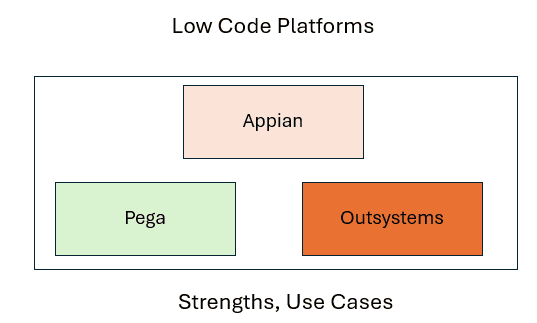

Appian
Appian is a low-code platform built on the philosophy of “Total Experience.” Its primary strength lies in end-to-end process automation and orchestration, seamlessly integrating people, data, bots (RPA), and AI into a single workflow. Appian’s focus is on uniting all enterprise resources to deliver a complete, automated business process. The platform is known for its “data fabric” which allows developers to connect and access data from multiple sources without migration, and a powerful, visual process modeler. Appian’s PaaS uses AWS as the underlying IaaS and LLM (Bedrock).
| Key Strengths | Description |
| Business Process Management (BPM) | Appian’s roots are in BPM, and it remains a leader in managing complex, human-centric workflows. |
| Data Orchestration | Its data fabric capability is a major differentiator, allowing for a unified view of data across the enterprise without having to move or replicate it. |
| Unified Automation | The platform excels at orchestrating a mix of human tasks, AI decisions, and robotic process automation (RPA) into a single, cohesive workflow. |
| Case Management | Appian is an excellent choice for dynamic case management where a process path is not always predictable (e.g., in a government agency or financial services). |
| Ideal Use Cases | Description |
| Complex Workflow Automation | Digitizing and automating intricate business processes like loan origination, insurance claims processing, or government permit applications. |
| Customer Experience Transformation | Creating unified portals and applications that provide a single view of the customer and automate all backend processes. |
| Supply Chain Management | Automating and optimizing complex supply chain workflows that involve multiple internal and external parties. |
Pegasystems (Pega)
Pega’s platform is designed for mission-critical, highly scalable enterprise applications. Its key differentiator is a powerful “Center-out” approach, which focuses on the core business logic and rules rather than the user interface. Pega is an AI-first platform, with its decisioning engine at the heart of everything it does. It’s often viewed as a platform for large-scale, strategic digital transformation projects. (Note, there is a U$2 billion lawsuit still pending with Appian. Appian is the plaintiff).
| Category | Description |
| AI and Decisioning | AI-powered decisioning engine, which enables personalised, real-time customer engagement and intelligent automation. |
| Intelligent Automation | The platform is purpose-built for automating highly complex, business-critical processes, often on a massive scale. |
| Enterprise Governance | Pega provides robust tools for managing and governing a large portfolio of applications, ensuring consistency and compliance across the organisation. |
| Customer Relationship Management (CRM) | Pega has a very strong suite of CRM applications for sales, service, and marketing that are highly configurable and intelligent. |
| Ideal Use Cases | Description |
| Personalised Customer Engagement | Delivering hyper-personalised experiences across all channels for industries like banking, telecommunications, and healthcare. |
| Massive-Scale Process Automation | Automating core operational processes in heavily regulated industries, such as claims processing in insurance or new account opening in banking. |
| Customer Service and Contact Centres | Powering intelligent contact centre applications that guide agents with AI-driven recommendations. |
OutSystems
OutSystems is a comprehensive low-code platform that puts a strong emphasis on developer productivity and the entire application lifecycle. It is often praised for its ability to build both lightweight, reactive web and mobile applications as well as complex, mission-critical core systems. OutSystems provides professional developers with a robust environment that supports a full range of modern architectural patterns and DevOps practices.
| Key Strength | Description |
| Developer-Centric | Provides a rich, visual environment that helps professional developers build complex, enterprise-grade applications quickly. |
| Full-Stack Development | Allows for the creation of front-end UI, business logic, and backend database integrations all within the same platform. |
| Scalability and Performance | Highly regarded for its ability to produce performant, scalable applications and manage the full application lifecycle, from development to deployment and maintenance. |
| Mobile-First Development | Provides excellent support for building native and progressive web apps for mobile devices. |
| Ideal Use Case | Description |
| Rapid Application Development | Building custom web and mobile applications to meet specific business needs, from internal tools to customer-facing portals. |
| Legacy System Modernization | Rebuilding or extending core legacy systems (e.g., on platforms like SAP or Salesforce) to improve functionality and user experience. |
| Enterprise Systems | Developing and managing a wide portfolio of custom applications for various departments within a company. |
| Modernizing Internal Apps | Quickly creating or updating internal-facing applications to improve employee efficiency. |